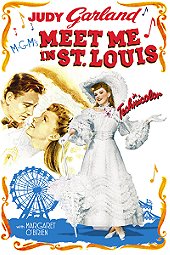It’s that subtle hint of darkness lurking underneath the sweet, colorful surfaces that makes Meet Me in St. Louis such a classic. Centering on a year-in-the-life of one typical suburban family pre-1903 World’s Fair, the story quietly details the triumphs and travails of the family, forfeiting a complicated narrative for the comfort of nostalgia. It is one of the greatest films ever made, and possibly Vincente Minnelli’s best-known film.
Perhaps the greatest thing about Meet Me in St. Louis is how it forgoes the prior conventions of screen musicals, there’s nary a stage performer putting on a show to be found. No hyper-stylized sets, no dream world of the impossibly rich, famous, and glamorous, just an upper-middle class family in realistic settings slowly breaking out into song to express their highs and lows throughout the year.
It opens in an ingenious way, introducing each of the various members of the family as they sing the title song, flowing throughout the house and revealing the entirety of the unit. From a younger daughter walking past her mother and the maid cooking ketchup in the kitchen, going upstairs and running into her grandfather, before pulling out and introducing the older siblings coming home from their social lives. It’s this combination of leisurely scope and pacing along with ambitious filmmaking that makes the film so unique.
Minnelli’s camera glides like a prima ballerina throughout. A scene in which Judy Garland, tough but tender and free from neurosis, leads Tom Drake through the various rooms in her house after a party, slowly turning down the lights in each, is a quiet bit of eroticism. Or the way it follows Garland’s slow-dance with her grandfather throughout the ballroom, behind a Christmas tree only to emerge in the arms of Drake, yet another bravura bit of directing that swells with romance.
Always a daring auteur with his films, Minnelli infuses much of Meet Me in St. Louis with a modern sensibility, making Garland and Lucille Brimer’s sisters the primary actors in their romantic entanglements and husband hunting. When Brimer warns Garland that men don’t want girls with the bloom taken off, Garland delivers a rejoinder about having too much bloom already. Yet Brimer’s not one for sitting idly by waiting for her prince charming. She hits him where it hurts and knows what the ultimate reaction will be.
At times Minnelli’s obsessive attention to detail could tip into strange, hallucinatory textures, proving that darkness was buried beneath these elaborate dioramas. Look no further than one of the odder detours in an MGM musical: the Halloween scene in which the children of the neighborhood gather to “kill” the adults by throwing flour in their face. Margaret O’Brien, death-obsessed and ever so slightly unhinged here, decides to take on the most-feared grown-ups by herself. Up to this point, the primary conflict had been a potential move away from St. Louis to New York City, or a missed marriage proposal, yet this scene goes full-tilt into the underside of the suburban paradise. After this, Meet Me in St. Louis doesn’t hold back from the various conflicts threatening to erupt the family.
“Have Yourself a Merry Little Christmas” has achieved a fame so vast outside of the film that it’s easy to forget how ironic the lyric is. It’s an intimate moment between Garland and O’Brien, an older sister trying to comfort the younger one, yet it throbs with the uncertainty of the future, the intangibility of time, how even holiday cheer can evaporate within an instant. In a film packed with knockout musical moments, there’s only about seven here, “Have Yourself a Merry Little Christmas” may be the standout. That’s really saying something considering “The Trolley Song”’s jubilance, “The Boy Next Door”’s sweet yearning, and energetic “Skip to My Lou.”
Is it any wonder that super-producer Arthur Freed, the man responsible for what we think of as the MGM musical treatment, dubbed Meet Me in St. Louis his personal favorite? While the surfaces are all about a nostalgic bit of Americana that may never have existed outside of the imagination, the film finds numerous ways to appear modern. This tension between naivety and progress make the film great.
Of course, it doesn’t hurt to have Judy Garland, Mary Astor, Leon Ames, Margaret O’Brien, Lucille Brimer, Tom Drake, and Marjorie Main leading your stellar ensemble. Garland and O’Brien are the true leads of the film, with the greatest moments and the best performances. Yet Brimer holds her own, a typically wooden actress under other director’s care, she flowers here. Same goes for Drake as the slightly daft, but very dreamy boy-next-door of Garland’s sexual fixation. Main, Astor, and Ames were old pros by this point, and they deliver their typically solid work as the salty maid, supportive mother, and obtuse father.
Meet Me in St. Louis is a perfect movie, and I say this with no hyperbole. Vincente Minnelli created quite a few masterpieces in his day (An American in Paris, The Bad and the Beautiful, Lust For Life, Some Came Running, and Cabin in the Sky being personal favorites), but Meet Me in St. Louis was the first. Only his third film, this was the first glimpse of what Minnelli was truly capable of as a director. It’s one of the best movie musicals ever produced, and a film to truly cherish.
 Login
Login